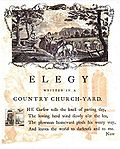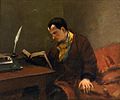Portal:Poetry
Welcome to the Poetry Portal


Poetry (from the Greek word poiesis, "making") is a form of literary art that uses aesthetic and often rhythmic qualities of language to evoke meanings in addition to, or in place of, literal or surface-level meanings. Any particular instance of poetry is called a poem and is written by a poet.
Poets use a variety of techniques called poetic devices, such as assonance, alliteration, euphony and cacophony, onomatopoeia, rhythm (via metre), and sound symbolism, to produce musical or other artistic effects. They also frequently organize these effects intos, which may be strict or loose, conventional or invented by the poet. Poetic structures vary dramatically by language and cultural convention, but they often use rhythmic metre (patterns of syllable stress or syllable (mora) weight). They may also use repeating patterns of phonemes, phoneme groups, tones (phonemic pitch shifts found in tonal languages), words, or entire phrases. These include consonance (or just alliteration), assonance (as in the dróttkvætt), and rhyme schemes (patterns in rimes, a type of phoneme group). Poetic structures may even be semantic (e.g. the volta required in a Petrachan sonnet).
Most written poems are formatted in verse: a series or stack of lines on a page, which follow the poetic structure. For this reason, verse has also become a synonym (a metonym) for poetry. (Full article...)
Selected article

Elegy Written in a Country Churchyard is a poem by Thomas Gray, completed in 1750 and first published in 1751. The poem’s origins are unknown, but it was partly inspired by Gray’s thoughts following the death of the poet Richard West in 1742. Originally titled Stanza's Wrote in a Country Church-Yard, the poem was completed when Gray was living near St Giles' parish church at Stoke Poges. It was sent to his friend Horace Walpole, who popularised the poem among London literary circles. Gray was eventually forced to publish the work on 15 February 1751, to pre-empt a magazine publisher from printing an unlicensed copy of the poem.
The poem is an elegy in name but not in form; it employs a style similar to that of contemporary odes, but it embodies a meditation on death, and remembrance after death. The poem argues that the remembrance can be good and bad, and the narrator finds comfort in pondering the lives of the obscure rustics buried in the churchyard. The two versions of the poem, Stanzas and Elegy, approach death differently; the first contains a stoic response to death, but the final version contains an epitaph which serves to repress the narrator's fear of dying. With its discussion of, and focus on, the obscure and the known, the poem has possible political ramifications, but it does not make any definite claims on politics to be more universal in its approach to life and death.
The poem quickly became popular. It was printed many times, translated into many languages, and praised by critics even after Gray's other poetry had fallen out of favour. Later critics tended to praise its language and universal aspects, but some felt the ending was unconvincing, failing to resolve the questions the poem raised; or that the poem did not do enough to present a political statement that would serve to help the obscure rustic poor who form its central image. (Full article...)
Selected image
Poetry WikiProject

Selected biography
Matsuo Bashō (松尾 芭蕉; 1644 – 1694), born error: error: {{nihongo}}: Japanese or romaji text required (help): Japanese or romaji text required (help), then Matsuo Chūemon Munefusa (松尾 忠右衛門 宗房), was the most famous poet of the Edo period in Japan. During his lifetime, Bashō was recognized for his works in the collaborative haikai no renga form; today, after centuries of commentary, he is recognized as the greatest master of haiku (then called hokku). Matsuo Bashō's poetry is internationally renowned; and, in Japan, many of his poems are reproduced on monuments and traditional sites. Although Bashō is justifiably famous in the West for his hokku, he himself believed his best work lay in leading and participating in renku. He is quoted as saying, “Many of my followers can write hokku as well as I can. Where I show who I really am is in linking haikai verses.”
Bashō was introduced to poetry young, and after integrating himself into the intellectual scene of Edo (modern Tokyo) he quickly became well known throughout Japan. He made a living as a teacher; but then renounced the social, urban life of the literary circles and was inclined to wander throughout the country, heading west, east, and far into the northern wilderness to gain inspiration for his writing. His poems were influenced by his firsthand experience of the world around him, often encapsulating the feeling of a scene in a few simple elements. (Full article...)
Did you know (auto-generated) -

- ... that hefker, unowned property in Talmudic law, came to express both personal freedom and societal abandonment in 20th-century Yiddish poetry?
- ... that Iraqi poet Kazim al-Samawi spent more than half his life in political exile and was called "The Sheikh of the Exiles"?
- ... that scholars debate whether Anactoria, mentioned in Sappho's poems, was a real person, a pseudonym, or an invention of Sappho?
- ... that the poem "Ovid in the Third Reich" has been described as "a classic reaction" to the Eichmann trial, despite being published before the trial was held?
- ... that Isabella Correa was one of the few Jewish women poets active in the Netherlands before the 19th century?
- ... that one reviewer for Women Philosophers in the Long Nineteenth Century was let down by the book's lack of poetry?
Selected poem
| Beyond Seas by Sohrab Sepehri |
|---|
|
I shall build a boat |
Related portals
Topics
Recognized content
Categories
Associated Wikimedia
The following Wikimedia Foundation sister projects provide more on this subject:
-
Commons
Free media repository -
Wikibooks
Free textbooks and manuals -
Wikidata
Free knowledge base -
Wikinews
Free-content news -
Wikiquote
Collection of quotations -
Wikisource
Free-content library -
Wikiversity
Free learning tools -
Wiktionary
Dictionary and thesaurus






















